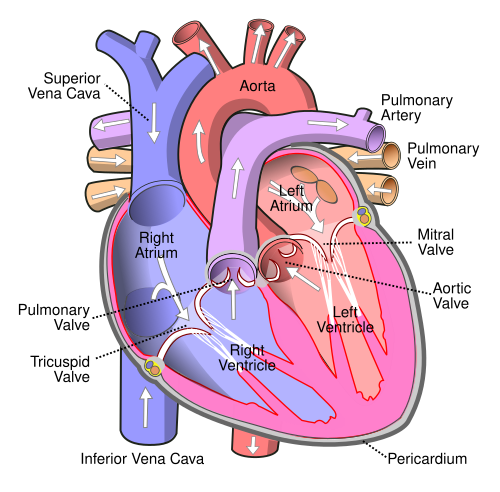Atrium (heart)

The atria (singular: atrium) are two of the four chambers of the human heart, the other two being the ventricles. They are thin-walled, upper chambers that play a crucial role in the circulation of blood within the heart.
Structure[edit]
The human heart has two atria:
- Right Atrium: The right atrium receives deoxygenated blood from two large veins, the superior vena cava and the inferior vena cava. It then contracts to push this blood into the right ventricle.
- Left Atrium: The left atrium receives oxygenated blood from the pulmonary veins. It contracts to pump this oxygen-rich blood into the left ventricle.
Function[edit]
The primary functions of the atria include:
- Receiving Blood: The right atrium receives deoxygenated blood returning from the body, while the left atrium receives oxygenated blood from the lungs.
- Transfer to the Ventricles: The atria contract to push blood into the respective ventricles. The right atrium sends blood to the right ventricle, which pumps it to the lungs for oxygenation. The left atrium sends blood to the left ventricle, which then pumps it into the systemic circulation to supply oxygen to the body's tissues.
- Atrial Kick: The atria contribute to the final stage of ventricular filling by providing an "atrial kick," a contraction that ensures the ventricles are adequately filled before they contract.
Electrical Signaling[edit]
The heart's electrical conduction system initiates and coordinates the contractions of the atria and ventricles. The sinoatrial (SA) node, often called the heart's natural pacemaker, generates electrical signals that stimulate atrial contraction.
Clinical Significance[edit]
Atrial function is crucial for effective heart function. Issues with the atria, such as arrhythmias or atrial fibrillation, can disrupt the normal heart rhythm and impair cardiac output. Conditions affecting the atria may require medical intervention, including medication or procedures like cardioversion.
Summary[edit]
The atrium or auricle is the upper chamber through which blood enters the ventricles of the heart. There are two atria in the human heart - the left atrium receives blood from the pulmonary (lung) circulation, and the right atrium receives blood from the venae cavae (venous circulation). The atria receive blood while relaxed (diastole), then contract (systole) to move blood to the ventricles. All animals with a closed circulatory system have at least one atrium. Humans have two atria.
| Anatomy and morphology | ||||||||||
|---|---|---|---|---|---|---|---|---|---|---|
|
| Anatomy of the heart | ||||||||||||||
|---|---|---|---|---|---|---|---|---|---|---|---|---|---|---|
|
Ad. Transform your life with W8MD's Budget GLP-1 injections from $75


W8MD offers a medical weight loss program to lose weight in Philadelphia. Our physician-supervised medical weight loss provides:
- Weight loss injections in NYC (generic and brand names):
- Zepbound / Mounjaro, Wegovy / Ozempic, Saxenda
- Most insurances accepted or discounted self-pay rates. We will obtain insurance prior authorizations if needed.
- Generic GLP1 weight loss injections from $75 for the starting dose.
- Also offer prescription weight loss medications including Phentermine, Qsymia, Diethylpropion, Contrave etc.
NYC weight loss doctor appointmentsNYC weight loss doctor appointments
Start your NYC weight loss journey today at our NYC medical weight loss and Philadelphia medical weight loss clinics.
- Call 718-946-5500 to lose weight in NYC or for medical weight loss in Philadelphia 215-676-2334.
- Tags:NYC medical weight loss, Philadelphia lose weight Zepbound NYC, Budget GLP1 weight loss injections, Wegovy Philadelphia, Wegovy NYC, Philadelphia medical weight loss, Brookly weight loss and Wegovy NYC
|
WikiMD's Wellness Encyclopedia |
| Let Food Be Thy Medicine Medicine Thy Food - Hippocrates |
Medical Disclaimer: WikiMD is not a substitute for professional medical advice. The information on WikiMD is provided as an information resource only, may be incorrect, outdated or misleading, and is not to be used or relied on for any diagnostic or treatment purposes. Please consult your health care provider before making any healthcare decisions or for guidance about a specific medical condition. WikiMD expressly disclaims responsibility, and shall have no liability, for any damages, loss, injury, or liability whatsoever suffered as a result of your reliance on the information contained in this site. By visiting this site you agree to the foregoing terms and conditions, which may from time to time be changed or supplemented by WikiMD. If you do not agree to the foregoing terms and conditions, you should not enter or use this site. See full disclaimer.
Credits:Most images are courtesy of Wikimedia commons, and templates, categories Wikipedia, licensed under CC BY SA or similar.
Translate this page: - East Asian
中文,
日本,
한국어,
South Asian
हिन्दी,
தமிழ்,
తెలుగు,
Urdu,
ಕನ್ನಡ,
Southeast Asian
Indonesian,
Vietnamese,
Thai,
မြန်မာဘာသာ,
বাংলা
European
español,
Deutsch,
français,
Greek,
português do Brasil,
polski,
română,
русский,
Nederlands,
norsk,
svenska,
suomi,
Italian
Middle Eastern & African
عربى,
Turkish,
Persian,
Hebrew,
Afrikaans,
isiZulu,
Kiswahili,
Other
Bulgarian,
Hungarian,
Czech,
Swedish,
മലയാളം,
मराठी,
ਪੰਜਾਬੀ,
ગુજરાતી,
Portuguese,
Ukrainian